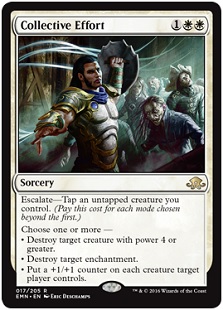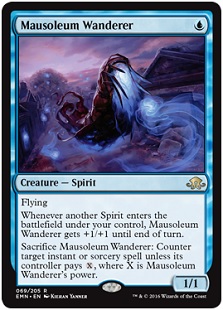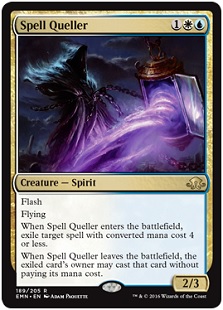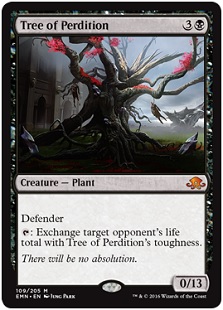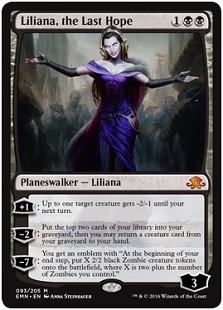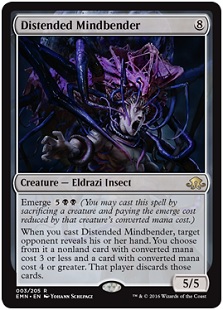You want to think about Standard brews. I want to think about Standard brews. I've been on Tomoharu Saito's U/R flyers deck for the last month because it was cheap, looked hilarious to play (which it is), and attacked the metagame's weak points. Now, there will be a new metagame to attack for awhile. In particular, I expect the greater tribal synergies available from releasing a second set of a tribal block will push the format in some different directions. And I don't mean synergy the way current Standard decks are synergistic, either; they're much more linear with some huge incentives to play those linear strategies (Humans), or they're independently great cards that work well enough together that you might as well play them (G/W Tokens). No, I mean decks that depend on their tribal synergies to thrive. I'll present one of those and one whose synergies are less obvious but possibly more potent.
Spirits Are a Faerie Cool Tribe
Spell Queller's getting a lot of hype, and why wouldn't it? A 2/3 flash flyer that's an Oblivion Ring for spells combines a bunch of things everyone likes playing in tournaments. The easiest comparison is to Thought-Knot Seer in that the eventual downside is worth the upside of pro-activity.
But Spell Queller's also a Spirit, and while there weren't nearly enough Spirits to even have a good Limited deck half the time, there are enough highly disruptive Spirits coming out to where Spirits is the closest thing we've ever had to Lorwyn-era Faeries. While it's true that Faeries got Bitterblossom and Thoughtseize,U/W isn't without its tricks. The shell will take awhile to optimize, I'm not great sketching out this sort of deck, but here's an example of the upside available:
U/W Spirits ? Eldritch Moon Standard | Brandon Isleib
- Creatures (26)
- 3 Anafenza, Kin-Tree Spirit
- 3 Archangel Avacyn
- 4 Bygone Bishop
- 4 Mausoleum Wanderer
- 4 Rattlechains
- 4 Selfless Spirit
- 4 Spell Queller
- Spells (10)
- 3 Essence Flux
- 4 Ojutai's Command
- 3 Collective Effort
- Lands (24)
- 10 Plains
- 6 Island
- 4 Port Town
- 4 Prairie Stream
There's a lot going on with this list, but the idea is a bunch of flyers that are also disruptive, combined with ways of making them more disruptive. There are 11 flash creatures in Rattlechains, Spell Queller, and Archangel Avacyn. Rattlechains can give the rest of them flash, and Ojutai's Command can reanimate over half the creatures. And they're not vanilla creatures, as Mausoleum Wanderer can counter instants and sorceries and Selfless Spirit's and Rattlechains's abilities will often get the same result. Ojutai's Command can always counter a creature spell, but this deck's group of Spirits means it can frequently counter a non-creature spell as well. Essence Flux blinking a Rattlechains can fizzle a spell while making Rattlechains beefier. Archangel Avacyn getting blinked doesn't make it bigger, but she's already Avacyn, so it's quite all right just to pay a Blue mana to give the team indestructibility.
As noted, Spell Queller has players' attention, with the other new cards in this deck a little behind them. But Selfless Spirit is the best Dauntless Escort we've seen, put on an aggressive flyer, and Mausoleum Wanderer is Judge's Familiar except that it's often a 2/2. Collective Effort is a little bit weird, but with as much flash as this deck has, tapping some creatures to escalate it isn't as much of a cost as it would be for some other decks. The following sequence is a Christmasland sort of example, but it's illustrative anyway:
Opponent: Green-White Tokens
- Them, turn one: Oath of Nissa
- You, turn one: Mausoleum Wanderer
- Them, turn two: Lambholt Pacifist
- You, turn two: nothing
- Them, turn three: (Pacifist transforms) Dromoka's Command to put a +1/+1 counter on Lambholt Butcher and fight Mausoleum Wanderer - you flash in Rattlechains to give the Wanderer hexproof
- You, turn three: Escalate Collective Effort, destroying Lambholt Butcher and Oath of Nissa and pumping your team
Sure, you're at 15 from the Lambholt Butcher swinging for five, but they and you have both spent three cards, and they have nothing while you've got a 3/2 flyer and a 2/2 flyer that can Rune Snag an instant or sorcery. It's not like they can play a Planeswalker into those flyers, and you've got a four-turn clock on them regardless of what else you do.
To be fair, that start depends heavily on a turn one Mausoleum Wanderer; the deck seems significantly worse without it. But there are a few more midrange plays that are still fine. Bygone Bishop investigates off every Spirit in the deck, and Anafenza, Kin-Tree Spirit's bolster can win some long games, especially as the abundance of flash creatures turns bolster into a combat trick.
For how many pros enjoyed playing Faeries, I expect that cards like Spell Queller and Mausoleum Wanderer are enough of a draw to those pros that Spirits will be one of the decks they put a lot of early effort into. For that reason, I also expect this deck to be good early or not at all. To me, it looks like the tools are there to be a real deck, the Spirit-ual successor to Faeries, even if it won't be quite as dominant.
When a Minus Is a Plus
I love Tree of Redemption. My deck of choice in Innistrad Standard was a R/G thing with a little bit of early ramp and Chandra, the Firebrand to copy either a post-combat morbid Brimstone Volley for ten damage to the dome or a Green Sun's Zenith for extreme value. There was a burn player in my casual group who, like me, would go to Friday Night Magic sometimes, and he hated Tree of Redemption in an irrational way. He'd sorta forget how to play Magic and just point random burn spells at it, like Narcis Prince after getting hit in the face.
We faced off one time in a tournament with these decks, and he'd brought in Manabarbs from the sideboard. I was at five life with five lands, a Tree of Redemption, and Chandra on the battlefield. On my turn, I tapped four lands, took the damage to go down to one life, exchanged my life total with Tree of Redemption to 13, tapped a fifth mana, then used Chandra to copy a Green Sun's Zenith with X at four to find a Thrun, the Last Troll and a second Tree of Redemption. I won that game.
So when Tree of Perdition was spoiled, I was all kinds of excited. One of my favorite cards coming back but with a sinister twist? Uh...yes please! But Tree of Perdition alters opponents' life totals, not your own, so it plays very differently. You don't want it in the same situations, and a 0/13 defender that saves your life is more obvious synergy than an 0/13 defender that hurts an opponent.
While all the coverage I've seen around Tree of Perdition looks at Triskaidekaphobia and assumes the two-card gotcha combo is the main thing to do with it, I think there will be too many aggressive decks and not enough tutoring power to build around the two cards that heavily. Instead, there are some other synergies that are otherwise playable and seem to be a more likely home for Tree of Perdition:
Black Tree Control ? Eldritch Moon Standard | Brandon Isleib
- Creatures (13)
- 1 Distended Mindbender
- 1 Liliana, Heretical Healer
- 3 Sidisi, Undead Vizier
- 4 Kalitas, Traitor of Ghet
- 4 Tree of Perdition
- Planeswalkers (7)
- 3 Ob Nixilis Reignited
- 4 Liliana, the Last Hope
- Spells (16)
- 2 Murder
- 2 Ultimate Price
- 4 Grasp of Darkness
- 3 Transgress the Mind
- 4 Languish
- 1 Tainted Remedy
- Lands (24)
- 21 Swamp
- 3 Geier Reach Sanitarum
Most of this is good Black control elements that don't need much explanation. You've seen the removal spells, with the reprint of Murder giving a much-needed catchall to control decks. But recent Black or W/B control shells haven't had amazing clocks of late. Gideon, Ally of Zendikar and Shambling Vent have been reliable, but they aren't fast. This is where Tree of Perdition comes in, as a decent anti-aggro card that shortens the clock when the finishers arrive. There's no need to worry about dealing incidental damage in this build; just land Tree of Perdition, exchange life totals, and take a couple swings to close things out.
The key to this plan is that, unlike nearly every tournament-playable creature (and unlike Tree of Redemption), Tree of Perdition gets better the lower its toughness is. Fortunately, it's in the color of toughness reduction. So while Grasp of Darkness and Languish are already fine removal spells, when they affect Tree of Perdition, they turn into burn spells. How awesome is that? Curve disruption and removal into a turn four Tree of Perdition, after which a turn five Languish makes Tree of Perdition a -4/9 - and the opponent's life total nine shortly afterward without having attacked. This plan also means that, if Grasp of Darkness is dead Game 1 due to a creature-less opponent or some similar plan, it can still be pointed at Tree of Perdition to speed the game up.
Triskaidekaphobia's gotten the combo hype with Tree of Perdition, but Tainted Remedy is more reliably good with it and turns it into a kill condition regardless of the rest of the board state. I had to write it down to make sure it all worked, but here's how Tree of Perdition kills someone with Tainted Remedy on the board, assuming no other life loss:
First exchange: Tree of Perdition becomes an 0/20 and the opponent goes to 13
Second exchange: Tree of Perdition becomes an 0/13 and attempts to put the opponent to 20, but Tainted Remedy replaces the seven points of life gain with life loss and takes the opponent to six.
Third exchange: Tree of Perdition becomes an 0/6 and attempts to put the opponent to 13, but Tainted Remedy kicks in and the opponents loses seven life, going to negative one
Yes, it's slower than Triskaidekaphobia, but it also lets you swing with other creatures to shorten the clock regardless of whether Tree of Perdition lives to enact its tainted plan. Plus, Tainted Remedy has enough random utility to be okay as a singleton meant to be found with Sidisi, Undead Vizier.
Speaking of singletons, Distended Mindbender isn't a card most decks want, but it's large enough to survive Languish, it emerges on-curve from a used-up Tree of Perdition, and it's heavily disruptive. Liliana, the Last Hope is here mostly as survival against swarm decks, with the expected typical outcome being killing a small creature and absorbing a couple attacks. That's good enough when trying to survive to Languish, and the ability to recur Kalitas, Traitor of Ghet or Sidisi, Undead Vizier is saucy.
And as far as it goes, this deck being mono-colored leaves it less vulnerable to Thalia, Heretic Cathar than most existing decks. It remains to be seen if that matters, but it's nice for now.
Conclusion
These are just a couple directions Standard could go ; the decks look different enough from the current metagame to lead me to think Eldritch Moon Standard could be pretty enjoyable. What are you looking forward to?
















